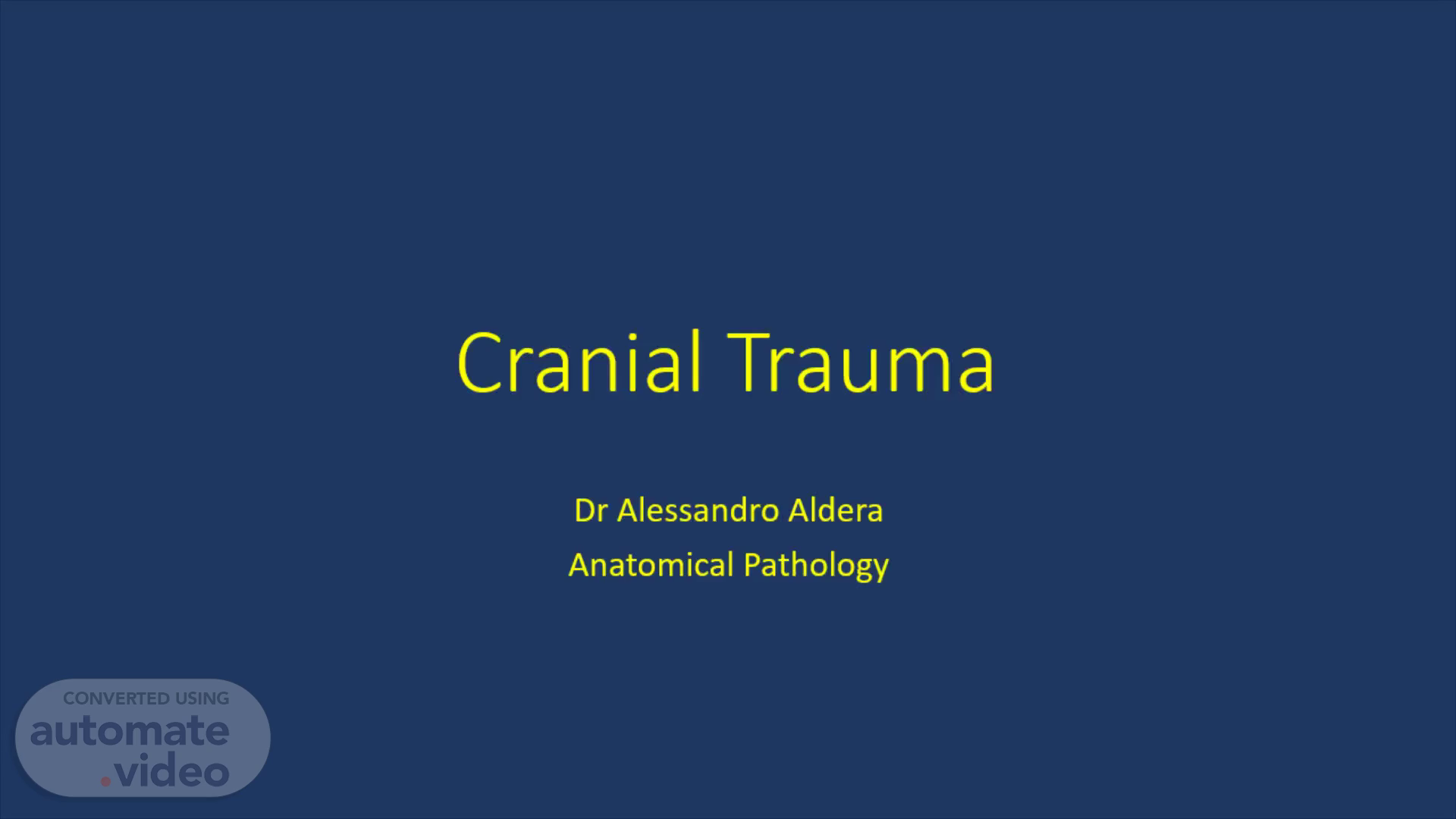Scene 1 (0s)
Cranial Trauma. Dr Alessandro Aldera Anatomical Pathology.
Scene 2 (7s)
Learning Objectives. Regarding cerebral trauma, describe the mechanisms, macroscopic appearance, evolution and prognosis of: i. contusions ii. coup an contrecoup injuries iii. subdural haemorrhages iv. extradural haemorrhages v. diffuse axonal injury.
Scene 3 (27s)
Background:. Significant cause of disability and death Severity and site of injury affect outcome Magnitude and distribution – shape of object, force and whether the head is in motion at the time of injury Broadly classified as: Penetrating, or Blunt.
Scene 4 (1m 1s)
Types of injury:. Skull fracture Parenchymal injury Contusions Coup and contrecoup Diffuse axonal injury Vascular injury Extradural, subdural, subarachnoid, parenchymal Combinations.
Scene 5 (1m 19s)
Skull Fractures. I.
Scene 6 (1m 25s)
Skull fractures:. Classified by the configuration or pattern it displays: Linear Depressed Compound Complications: Brain haemorrhages Infections (abscess/meningitis).
Scene 7 (2m 2s)
Parenchymal Injuries.
Scene 8 (2m 7s)
Contusions:. Impact of an object with the head leading to: Collision of brain with skull at site of impact (coup) Opposite side (contrecoup) Both coup and contrecoup injuries are contusions Similar gross and microscopic appearances Crests of gyri most susceptible (cortex along sulci less vulnerable) Rapid tissue displacement disruption of vascular channels subsequent haemorrhage, tissue injury and oedema.
Scene 9 (2m 51s)
Contusions:. Frontal lobes along the orbital gyri and temporal lobes most susceptible Penetration of the brain causes laceration with tissue tearing, vascular disruption, haemorrhage and injury in a linear path.
Scene 10 (3m 21s)
Acute contusion – haemorrhagic necrosis and oedema Gradually macrophages migrate in and mop up debris Contusions evolves into a yellow plaque with atrophy and gliosis.
Scene 12 (4m 5s)
Subdural haematoma.
Scene 13 (4m 11s)
Acute subdural haematoma:. Seen in 12% to 29% of severe TBI Mortality rate of 40% to 60% Rupture of bridging (emissary) veins Individuals with brain atrophy (elderly) are particularly susceptible and can sustain ADH with minor trauma.
Scene 14 (5m 3s)
A car parked on the side of a road Description automatically generated.
Scene 16 (5m 28s)
Sequalae:. Initially the subdural haematoma is a flat blood clot not attached to the dura Fibroblast ingrowth causes organization After 10-20 days – outer membrane is formed Then inner membrane forms Subdural becomes entirely encapsulated Further organization leads to formation a sac with a fibrous wall (chronic subdural haematoma).
Scene 18 (6m 42s)
Extradural haematoma.
Scene 19 (6m 48s)
Epidural haematoma:. Seen in 2.7-4% of TBI Mortality of approximately 10% Cranial fractures present in 70-90% Most commonly with fractures of the temporal or parietal bones Tearing of middle meningeal artery Bleeding lifts the dura off the skull Convex shape on imaging Symptoms of raised ICP develop rapidly.
Scene 22 (8m 18s)
Diffuse Axonal Injury.
Scene 23 (8m 24s)
Diffuse Axonal Injury (DAI):. DAI is a special traumatic lesion Frequently seen in MVAs when the head is unsupported Parts of the of the brain move relative to adjacent parts (shear forces) Rarely a pure lesion (can be difficult to separate from other TBI pathology).
Scene 24 (8m 56s)
Pathophysiology:. Axons are stretched changes in axonal cytoskeleton Mitochondria accumulate proximally (spheroids) Mitochondrial dysfunction Leads to axonal rupture Neuroinflammation Wallerian degeneration Multifaceted process Evolution over time Most severe damage is along midline structures.
Scene 25 (10m 17s)
Clinical:. Severe DAI – unconscious immediately May recover or go into persistent vegetative state Reticular activating substance May have additional widespread vascular injury in severe TBI..
Scene 26 (10m 53s)
Pathology:. Petechial haemorrhages in: Corpus callosum Dorsolateral brainstem Other areas Due to tearing of blood vessels Microscopically axonal swellings ( spheroids ) are seen BAPP immunohistochemistry.
Scene 28 (11m 53s)
Pediatric Head Trauma Presented by Jennifer L. Ross, M.D. - ppt ....
Scene 30 (12m 15s)
Axonal sphenoids (swelling of the axon). Occurs 12-24 hrs after diffuse axonal injury. beta amyloid can accumulate in them with Alzheimer's disease.
Scene 32 (12m 36s)
Sasi Wallpaper - Cape Town Landscape.
